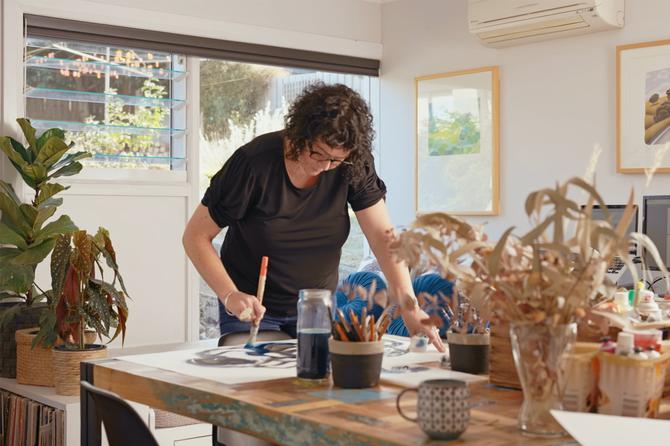Linda Crispin has a very large shed in her backyard. She has equally big plans for it, and her Diploma of Creative Arts and Health will help her make those ideas a reality.
Linda graduated with a Bachelor of Fine Arts (Painting) in 2017 and said that as much as she loved painting and drawing and creating art, she very soon realised she wanted to use art for a different purpose.
“Fine Arts is fantastic for a creative person,” she said. “A Fine Arts degree teaches you strategies for how to make it, contextualise it and experiment with it.
“What this course does, is it actualises your creativity. It’s a way to look at and use your art to work with other people. I will always be an artist, I live to create, but I want to use it to engage more with the community.”
The Diploma of Creative Arts and Health teaches innovative uses of creative arts in a range of community and health-care settings, while developing an understanding of the effects of the arts on the brain and body in a social and cultural context.
Linda was inspired to study the diploma because of her personal interest in the benefits of art therapy in the aged care sector, particularly in relation to dementia.
“I have some family history – one grandparent had Alzheimer’s and another had dementia – so I have lived that firsthand and seen what the decline looks like.
For me, working with people to give them a better quality of life in their later life, that appeals to me. To maintain and encourage cognitive function through using creative arts whether that be music, dance, theatre, or visual art.
But aged care was just one possible avenue for the skills that Linda was learning. Now she is focusing on creating a community art space to help others discover the joy of creating art.
Which brings us to that shed.
“I have this big old shed in my backyard, it’s one of the reasons I bought the house,” Linda said. “It’s currently being converted into a working studio. And I would like to open it up to creative classes.

Linda working on her creative practice at home in between juggling family, work and study.
“Whether that’s creative workshops where you can come and play with mediums and ideas, or bringing in community groups or smaller groups in a more inclusive context, to help people feel good through the creative arts.
“In this context, it’s not necessarily about creating an artwork, it’s about what you do to create the artwork. And if you come out at the end with something totally unique and can say yeah, I made that, that’s also a benefit.”
Linda said her art, which was primarily painting and drawing, tended to focus on the human condition and the way we interact with and experience the world.
But she also pointed out that it was not necessary to be an artist to do the course.
You can simply be interested in creativity and not an artist yourself, it’s accessible to everybody. It’s amazing what you can do without any creative experience whatsoever, just an interest in it.
She said the online study experience was also easily accessible and navigable. She was pleasantly surprised by the interaction and community atmosphere of the online portal, especially the discussion groups, specifically designed to encourage engagement between students from around the country.
“I’m a full-time worker and a busy mum of two, so if this hadn’t been offered online I wouldn’t have been able to do it.
“I don’t have a lot of time in my week but studying this way meant I could fit it in around my work and my home life as well. I can read through the online content at start of the week, look at what activities are due for the week, then I can study for a couple of hours each day to get everything done.”
Find out more about our courses in Creative Arts and Health and Fine Arts.


